Glenelg Ark
Overview
The Glenelg Ark project was established in 2005 in far south-west Victoria under the Department of Sustainability and Environment Weeds and Pests on Public Land Initiative as a landscape scale fox control project and has been operating continuously since then.
The project is a collaboration between the Department of Environment, Land, Water & Planning (DELWP) and Parks Victoria. The project aims to facilitate the recovery of native mammal populations at risk from predation by foxes in far south-west Victoria by undertaking broad-scale and continuous fox baiting using buried Foxoff® in a planned and systematic approach.
Area
By 2016 the program had expanded from its original 10,000 ha in 2005 to cover 90,000 ha of state forest and national park of which 70,000 ha is baited (Treatment Management Zones) and 20,000 ha not baited (Non Treatment Management Zones).
Treatment zones:
- Lower Glenelg National Park (south)
- Cobboboonee National Park
- Mount Clay State Forest
Non treatment control zones:
- Hotspur State Forest
- Annya State Forest
- Lower Glenelg National Park (north)
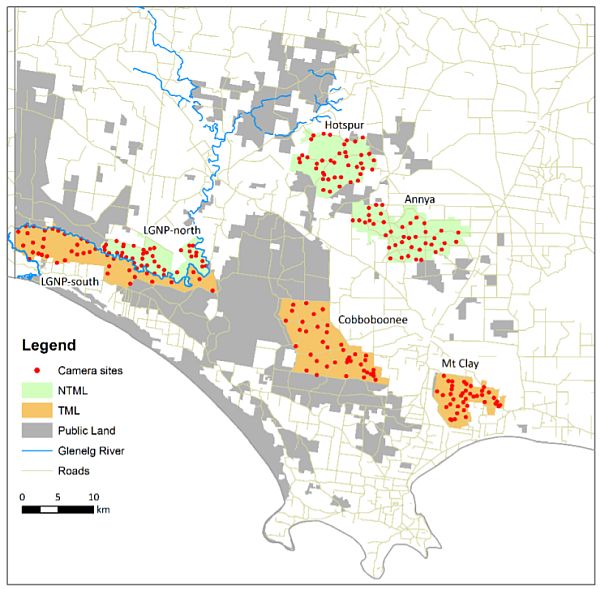
Monitoring sites in the Glenelg Ark project. Tan = Treatment Monitoring Locations (baited areas); Green = Non-Treatment Monitoring Locations (non-baited areas). Red dots indicate camera monitoring sites. Source: ARI Technical Report 318.
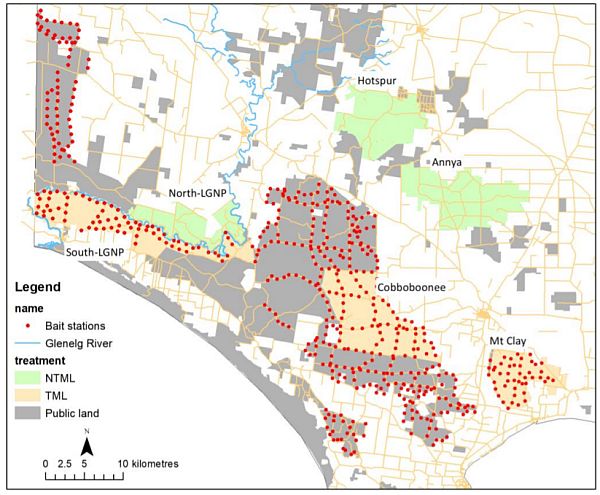
Red dots indicate poison bait stations. Green = non-treatment monitoring locations (NTML). Tan = treatment monitoring locations (TML), Grey = other areas outside the project monitoring area. Source: ARI Technical Report 318. Fox baiting along Discovery Bay Coastal Park was included in the program from 2011 for Hooded Plover protection but discontinued in 2017.
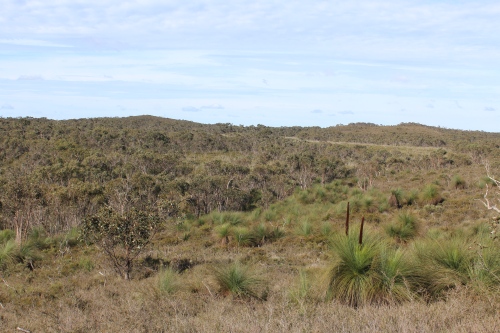
Monitoring selected species
Glenelg Ark incorporates a comprehensive monitoring plan designed to evaluate the benefits of reducing populations of the Red Fox Vulpes vulpes to two native ground-dwelling mammal prey species Southern Brown Bandicoot Isoodon obesulus Long-nosed Potoroo Potorous tridactylus, and one arboreal species Common Brushtail Possum Trichosurus vulpecula. These species have been monitored annually at 40 sites established within each treatment monitoring location and non-treatment monitoring location.
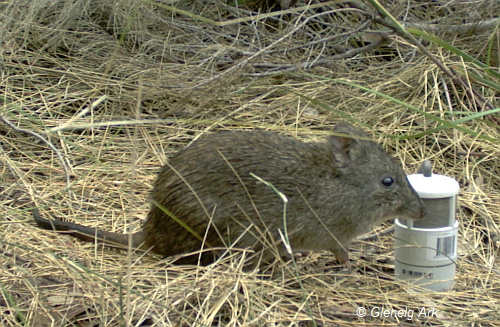
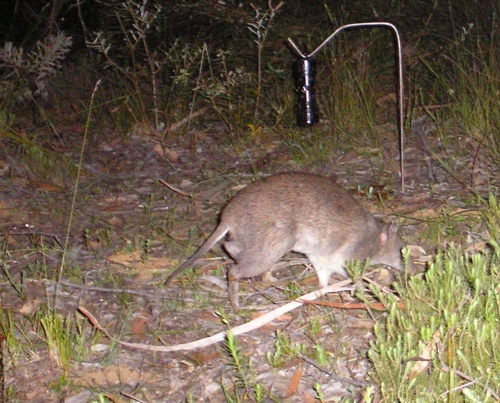
Monitoring results
Results from the Glenelg Ark project have been regularly reviewed. At least four technical reports have evaluated how the aims of the project have been met. The technical reports also provide in-depth information and analysis on fox and feral cat control at treated and untreated areas and population trends and occupancy of the three target species; Long-nosed Potoroo, Southern Brown Bandicoot and Common Brushtail Possum.
2014 review
Glenelg Ark 2005–2013: Evidence of the Benefits for Native Mammals of Sustained Fox Control (Robley et al. 2014).
The results of Glenelg Ark’s nine-year management project demonstrated that the fox population can be reduced and maintained at relatively lower levels in fragmented landscapes, and that fox control has had a generally positive effect on the occurrence of the three native mammal species.
The report found there had been a significant decline in bait take from 2005 to 2013 in the Treatment Management Zones (TMZs), and a significant difference between TMZs and Non-Treatment Management Zones (NTMZs) between 2005 and 2013. Overall, each of the three monitored native prey species had a significant positive response in site occupancy to fox control. However, factors that drive population change, i.e., colonisation and persistence were not uniformly positive for all species or all treatment management zones.
The report discussed alternative hypotheses that could explain the observed variable response within the treatment zones; natural resources may limit the population's capacity to persist in newly colonised sites, or that foxes have been replaced by feral cats as the introduced predator. The report highlighted that further investigation are needed to ensure the project is facilitating the recovery of small and medium sized mammals at risk.
In order to continually improve the management outcomes of the Glenelg Ark project, the 2014 report contained a revised set of aims:
- Maintain the conservation gains achieved to date.
- Increase our understanding of the drivers for apparent recent decline in Southern Brown Bandicoots.
- Evaluate the possible broader conservation gains of the program. i.e. other species in the project area that are not currently monitored but are thought to benefit from fox control.
- Integrate risk-based fire planning and predator control actions for key response species into the program.
- Improve efficacy of predator control operations so that the project continues to be a best practice examples of integrated and landscape scale predator control.
2017 review
Glenelg Ark: Benefits to biodiversity from long-term fox control, 2005 to 2016 ARI Technical Report 275, Alan Robley, Paul Moloney, Georgina Neave and David Pitts, August 2017.
This report contained monitoring activities between 2013 to 2015 and was released by Arthur Rylah Institute in August 2017. The report provided new information on the fox control program and an assessment of monitoring techniques (hair-tubes vs digital cameras).
Hair-tubes vs digital cameras
It was found there was no overall significant difference in detection rates between cameras and hair-tubes; however, cameras are less costly to operate and are able to ‘capture’ a wider range of species in all weather conditions. The project will now use digital cameras for future monitoring.
Fox activity & feral cats
The 2017 report concluded fox activity at locations with fox control was significantly lower compared with activity at locations without fox control.
There was no significant difference in Feral Cat activity between sites with and without fox control, although there are indications which suggest there could be instances where higher levels of Feral Cat activity may occur in treated areas.
Fox control response to Common Brushtail Possum, Southern Brown Bandicoot and Long-nosed Potoroo
The 2017 report demonstrates how results can vary from year to year. In 2013, there was strong evidence of a positive effect on site occupancy from fox control on Common Brushtail Possums and Long-nosed Potoroos and inconclusive evidence of a positive effect on Southern Brown Bandicoots. In 2014, there was no evidence of an effect for Common Brushtail Possums, Southern Brown Bandicoots and Long-nosed Potoroos. In 2015, it was found the number of sites occupied by Long-nosed Potoroos was greater at locations with fox control.
When taking a longer-term view between 2005 and 2015, sites occupied by Common Brushtail Possums remained higher in treatment locations compared with the number in non-treatment locations. Little change was observed for Long-nosed Potoroos and site occupancy of Southern Brown Bandicoots remained unchanged.
An important point is that native species site occupancy remains higher at locations with fox control than it was at locations with no fox control when Glenelg Ark commenced in 2005.
The limited response of bandicoots and potoroos may be due to a lack of suitable habitat for these species. Another factor to be considered is over the 10 years since the project began in 2005, there were 7 years with below-average rainfall.
The 2017 report also made a number of recommendations to improve outcomes of the Glenelg Ark project.
2020 review
Glenelg Ark 2005–2019: long-term predator and native mammal response to predator control, ARI Technical Report 318, November 2020, Alan Robley , Paul Moloney , Louise Stringer and Simon Donald.
This report provides a summary of findings since the Glenelg Ark project commenced in 2005. After 14 years of fox control undertaken by the Glenelg Ark project, which has reduced the level of fox activity significantly, there is only a small positive change in occupancy rates of Long-nosed Potoroo and Southern Brown Bandicoot.
Long-nosed Potoroo occupancy rates did not increase consistently, but were generally higher at Treatment Monitoring Locations (TML’s) s, and they have slowly but steadily declined at Non- Treatment Monitoring Locations (NTMLs).
Southern Brown Bandicoot occupancy rates have generally been higher at TMLs, except for 2013. The high degree of uncertainty in the estimates means it is not possible to state whether occupancy is higher at TMLs, statistically.
Common Brush-tailed Possum occupancy rates increased on both TMLs and NTMLs, with occupancy generally higher at TML’s.
Fox activity was 88% higher across the non-treatment areas.
Within the Glenelg Ark operations area, the sustained reductions in fox populations may have resulted in increased activity (and possibly abundance) of feral cats.
The report summarises that the lack of a significant response in Southern Brown Bandicoot and Long-nosed Potoroo after 14 years of fox control is of concern. Possible explanations:
- The current sampling methodology is insensitive to the scale of change in occupancy, or occupancy is an inferior metric for abundance; thus, the result is an underestimate of the scale of population change that has occurred across the landscape.
- Landscape disturbance, e.g. the long-term effects of frequent burning (both planned and natural), has resulted in a highly fragmented landscape. Populations are now restricted to isolated refugia, and species are unable to bridge the gaps between them. Both species have now filled the available niche and are limited by competition for suitable habitat.
- Fox densities are still too high and limit the population growth of small fragmented populations of Southern Brown Bandicoot and Long-nosed Potoroo.
- Feral cats have replaced foxes as the main predator, with potentially similar dynamics to those of foxes.
- Some combination of the above, or some unknown and unanticipated factors.
The latest report mentions other species which might also benefit from fox control, e.g., Heath Mouse and Common Ringtail Possum. Owl species such as the Australian Masked Owl and Powerful Owl might also respond positively to effective fox control as a result of increases in native prey such as possums.
Recommendations contained in the latest report
The report recommends that a Glenelg Ark strategic plan be developed that articulates the projects long-term outcomes and how these will be achieved and assessed. This plan should consider the following strategies for improving our current knowledge and aid managers in making informed decisions on the future direction of the Glenelg Ark project:
- Develop a strategy to further reduce fox density
- Increase the density of baits at TMLs, and robustly assess the outcome in terms of the fox, feral cat and native species response. Strategy to improve understanding of native species response
- Increase the number of camera sites to improve detection rates for Southern Brown Bandicoot and Long-nosed Potoroo
- Model the patterns in the changes in occupancy from 2005 to 2018 to investigate factors that may influence the spread of recovery
- Develop Southern Brown Bandicoot and Long-nosed Potoroo habitat suitability surfaces for the Glenelg Ark project area (using presence/absence data) to aid in setting species response targets and to identify potential new control and/or monitoring sites
- Using expert elicitation, describe the benefits of fox control for the Heath Mouse (Pseudomys shortridgei); select sites for targeted monitoring within TMLs and NTMLs. Strategy to integrate feral cat and fox control
- Implement targeted feral cat control at selected locations with known populations of Southern Brown Bandicoots.
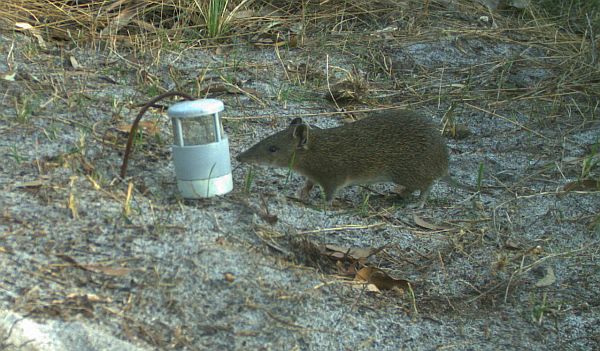
Southern Brown Bandicoot at monitoring station 6 pm, 4 December 2020. Source: glenelg Ark.
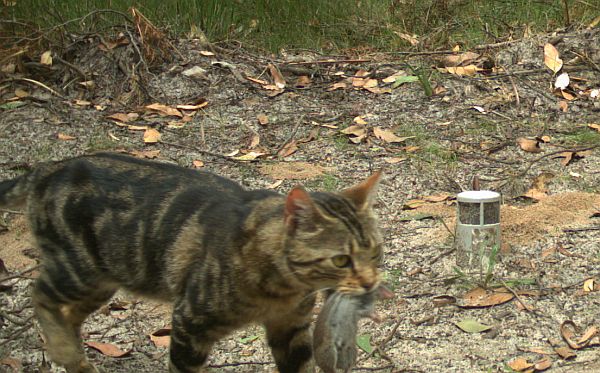
Feral Cat with prey at monitoring site 12.14 pm on 2 December 2020. Source: Glenelg Ark.
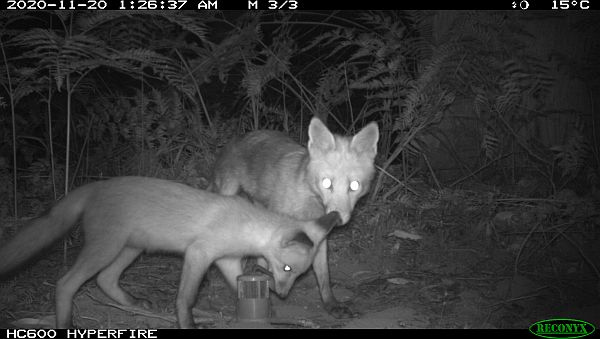
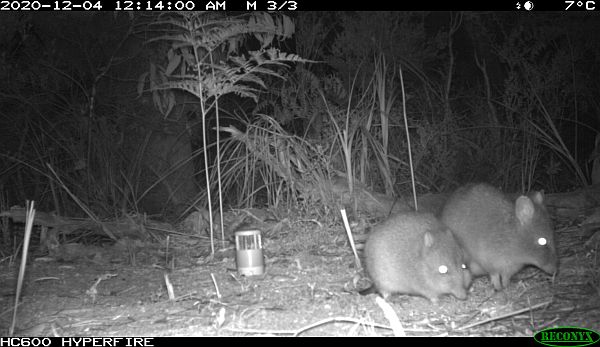
2022
ARI Technical Report 340 - 2020 Monitoring and Evaluation Update, July 2022 pdf
Conclusions and implications: This analysis has shown that, for Long-nosed Potoroo and Southern Brown Bandicoot, fox control has made a substantial positive difference in site occupancy. Both colonisation and persistence rates for Long-nosed Potoroo and Southern Brown Bandicoot were higher at fox control locations than at locations without fox control. This has resulted in growth (new sites becoming occupied over time), and this has been consistently higher at locations with fox control. The colonisation and persistence rates of Common Brushtail Possums were less influenced by fox control, although it was an important factor, with rates being higher at locations with fox control.
Progress reports:
- Glenelg Ark 2005–2013: Evidence of the Benefits for Native Mammals of Sustained Fox Control (Robley et al. 2014)
- ARI Technical Report No. 275 Glenelg Ark 2015 update: benefits to biodiversity from long-term fox control (Robley et. al. 2016)
- ARI-Technical-Report 226. Glenelg-Ark-2005-2010 evidence of sustained control of foxes and benefits for native mammals (Robley et. el. 2011)
- ARI Technical Report 318, Glenelg Ark 2005–2019: long-term predator and native mammal response to predator control, November 2020, Alan Robley , Paul Moloney , Louise Stringer and Simon Donald.
- ARI Technical Report 340 - 2020 Monitoring and Evaluation Update, July 2022 pdf
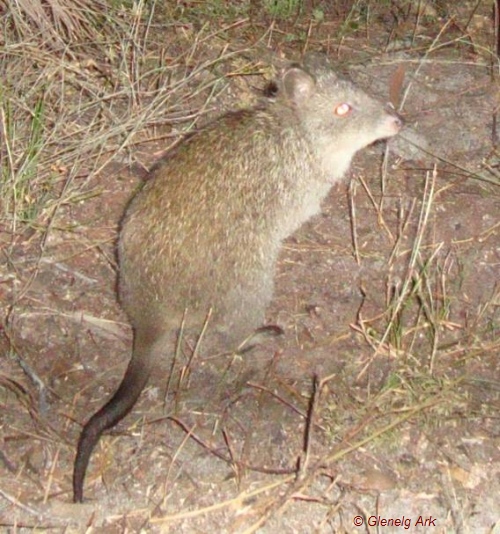
For further information contact: Ethan Le Duc, Glenelg Ark Project officer, DELWP, Heywood, Victoria.
See also:


